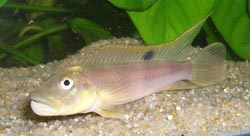Cichlid fish: How does the swim bladder affect hearing?

Steatocranus tinanti has a tiny reduced swim bladder. Credit: Friedrich Ladich<br>
The hearing sensitivity improves considerably in this way. The anterior part of the swim bladder functions in specialized fish species similar to an ear drum. Up to now the effects of the different swim bladder morphologies have not been investigated in detail in cichlid fishes.
The behavioural biologists of the University of Vienna Tanja Schulz-Mirbach and Friedrich Ladich as well as Brian Metscher from the Department of Theoretical Biology of the University of Vienna studied the relationship between the shape of the swim bladder and its function. “These fish are perfect for such an investigation because this fish family possesses a large variety of swim bladders ranging from tiny reduced ones to large highly specialized swim bladders with extensions up to the inner ear”, the bioacoustician Tanja Schulz-Mirbach explains.
Different swim bladders
Currently we know approximately 1,300 species of cichlid fishes, which live in various habitats.”Using microtomographic methods in cooperation with Brian Metscher we could reconstruct swim bladder specializations in detail”, Tanja Schulz-Mirbach says. Some cichlid species such as the bottom-living Steatocranus tinanti inhabit fast flowing waters in the Congo river basin and their swim bladders are widely reduced. Cichlids which live in rather calm waters possess large bladders which either lack a connection to the inner ear such as the jewel cichlid Hemichromis guttatus or which possess anterior extensions bringing the swim bladder close to the inner ears. The Malagasy species Paratilapia polleni has simple tube-like swim bladder extensions whereas the Indian cichlid Etroplus maculatus has more complex extensions consisting of a gas-filled tube and a tissue pad which touches the inner ear.
Size matters
Biologists in the bioacoustic lab of Friedrich Ladich measured hearing by recording acoustically evoked potentials (similar to EEGs) from the head of animals non-invasively. “We could show that species having specialized swim bladders detect higher sound frequencies and lower sound levels than species having reduced swim bladders”, Schulz-Mirbach explains. However, the jewel cichlid which has a large swim bladder but no connection to the inner ear is also able to detect frequencies up to 3 kHz but only at higher sound levels. “This means that the presence of anterior swim bladder extensions results in better hearing but the size of the swim bladder is also important”, explains Schulz-Mirbach says. She will continue to investigate the importance of the habitat noise on the development of hearing and if swim bladder specializations affect inner ear anatomy.
Publication:
“Relationship between swim bladder morphology and hearing abilities. A case study on Asian and African cichlids”: Tanja Schulz-Mirbach, Brian Metscher, Friedrich Ladich (PLoS ONE 2012) DOI: http://dx.plos.org/10.1371/journal.pone.0042292
Contacts:
Dr. Friedrich Ladich
Department of Behavioural Biology
1090 Vienna, Althanstraße 14 (UZA I)
T +43-1-4277-542 27
friedrich.ladich@univie.ac.at
Dr. Tanja Schulz-Mirbach
Department of Behavioural Biology
1090 Vienna, Althanstraße 14 (UZA I)
T +43-1-4277-544 30
tanja.schulz-mirbach@univie.ac.at
Media Contact
More Information:
http://www.univie.ac.atAll latest news from the category: Life Sciences and Chemistry
Articles and reports from the Life Sciences and chemistry area deal with applied and basic research into modern biology, chemistry and human medicine.
Valuable information can be found on a range of life sciences fields including bacteriology, biochemistry, bionics, bioinformatics, biophysics, biotechnology, genetics, geobotany, human biology, marine biology, microbiology, molecular biology, cellular biology, zoology, bioinorganic chemistry, microchemistry and environmental chemistry.
Newest articles

A universal framework for spatial biology
SpatialData is a freely accessible tool to unify and integrate data from different omics technologies accounting for spatial information, which can provide holistic insights into health and disease. Biological processes…

How complex biological processes arise
A $20 million grant from the U.S. National Science Foundation (NSF) will support the establishment and operation of the National Synthesis Center for Emergence in the Molecular and Cellular Sciences (NCEMS) at…

Airborne single-photon lidar system achieves high-resolution 3D imaging
Compact, low-power system opens doors for photon-efficient drone and satellite-based environmental monitoring and mapping. Researchers have developed a compact and lightweight single-photon airborne lidar system that can acquire high-resolution 3D…





















